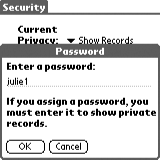Other Design Issues
Most applications contain a certain number of core user interface elements. Even the simplest application will, at the very least, need a form and some controls. Most applications go well beyond the minimal number of features and have multiple menus, forms, and dialog boxes. You will have to decide about these forms, as well as the types of screens (black and white, grayscale, color, pixel depth) that you will support. There are also OS versions to support or ignore. Finally, and most importantly, there are a couple of gotchas that commonly get programmers from the desktop world. Let’s look at these first.
Gotchas from the Desktop
There are two common problems that desktop programmers stumble upon when they enter the handheld world: what to do about passwords and where to put the Exit button. Thankfully, we can tell you exactly what to do about both of these situations.
Handling passwords on a handheld
In the desktop world, it is common to present a dialog box in which the user enters a password where the actual letters or digits in the password are obscured with asterisks (*) or other symbols. You must not obscure a password on a Palm handheld. Instead, show the actual letters and digits the user enters in the dialog box (see Figure 3-44).

Figure 3-44. Entering a password in the Security application Password dialog box
You also need to show the actual letters and ...
Get Palm OS Programming, 2nd Edition now with the O’Reilly learning platform.
O’Reilly members experience books, live events, courses curated by job role, and more from O’Reilly and nearly 200 top publishers.

